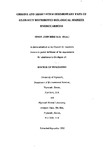ORIGINS AND SHORT-TERM SEDIMENTARY FATE OF GLOBALLY DISTRIBUTED BIOLOGICAL MARKER HYDROCARBONS
| dc.contributor.author | HIRD, SIMON JOHN | |
| dc.contributor.other | School of Geography, Earth and Environmental Sciences | en_US |
| dc.date.accessioned | 2013-10-10T10:02:49Z | |
| dc.date.available | 2013-10-10T10:02:49Z | |
| dc.date.issued | 1992 | |
| dc.identifier | NOT AVAILABLE | en_US |
| dc.identifier.uri | http://hdl.handle.net/10026.1/2142 | |
| dc.description.abstract |
Nearly thirty C20, C25, and C30 highly branched isoprenoid (HBI) hydrocarbons have been detected, sometimes in high concentrations, in recent freshwater, estuarine, coastal and hypersaline sediments, and water column particulate matter from numerous locations worldwide. The parent structures have been proved but only a few of the double bond positions have been established. The assignment of C21, C22 and C26 homologues and other C20 and C25 isomers, remains tentative. A wide body of evidence suggests that the compounds are biogenic in origin, with algae and possibly bacteria the most likely source organisms. A few of the compounds have been identified in field samples of algae but none have been reported in laboratory cultured biota. The alkenes with more than two double bonds appear to be rapidly removed from the hydrocarbon fraction in most sediments, whereas the alkanes and monoenes seem to be more resistant to biodegradation and hence occur in some more ancient sediments and oils. There is evidence that some of the alkenes react rapidly with sulphur to form either S-containing HBI heterocycles or become bound within macromolecular aggregates both found in sediments and some oils. The compounds, both as hydrocarbons and S-containing analogues, may prove useful environmental indicators once the sources and exact structures of more of them have been established. In the literature the structural elucidation of C25 and C30 alkenes has been based mainly on the analysis of their hydrogenation products. However, some authors concluded that the alkenes are cyclic since some could not be fully hydrogenated. The structure of a C25 HBI diene was proven to be a cyclic by hydrogenation studies and GC and GCMS analyses which showed the HBI compound to be fully saturated. The isolation and characterisation of synthetic alkenes resulted in the assignment, or partial assignment, of structures to four C20, six C25 and four C30 monoenes. The formation of novel monoenes via isomerisation reactions has also been achieved. The compounds form a valuable database of chromatographic and spectroscopic information for the assignment of sedimentary alkenes but the importance of isolation and micro-ozonolysis has been emphasised. Synthetic HBI alkenes were used to assign structures and partial structures to naturally occurring HBI hydrocarbons in three sediments. Other monoenes (both with methylene double bonds) were isolated from the sediments and characterised using spectroscopic and micro-ozonolysis data. The widespread occurrence of C20 and C23 HBI hydrocarbons in Tamar sediments and associated algae (macrophytes and diatoms), the large variation in isotopic composition evident for the C20 monoene, and the seasonal sedimentary distribution all suggest two possible sources for the HBI hydrocarbons; microalgae and/or heterotrophic bacteria. Investigation of the distribution of hydrocarbons from the Peru upwelling area confirmed the rapid decrease in concentration of C25 HBI alkenes with depth. A mixture of HBI monoenes was successfully incorporated into melanoidins but not detected in the humic acid pyrolysate which implied that incorporation of HBI alkenes into accreting humic substances was not a major mechanism of diagenesis of HBI alkenes. This study has extended present knowledge of the structures of HBI monoenes and has suggested two possible biological sources. There is still much to be learned about HBI polyenes and the subject is proving to be a fruitful area for further research into biomarker potential. Some possible future approaches are suggested. | en_US |
| dc.language.iso | en | en_US |
| dc.publisher | University of Plymouth | en_US |
| dc.title | ORIGINS AND SHORT-TERM SEDIMENTARY FATE OF GLOBALLY DISTRIBUTED BIOLOGICAL MARKER HYDROCARBONS | en_US |
| dc.type | Thesis | |
| plymouth.version | Full version | en_US |
| dc.identifier.doi | http://dx.doi.org/10.24382/3611 | |
| dc.identifier.doi | http://dx.doi.org/10.24382/3611 |
Files in this item
This item appears in the following Collection(s)
-
01 Research Theses Main Collection
Research Theses Main


